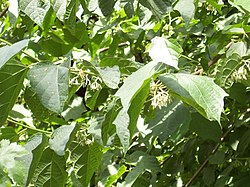Alangium
Genus of flowering plants From Wikipedia, the free encyclopedia
Alangium is a small genus of flowering plants. The genus is included either in a broad view of the dogwood family Cornaceae, or as the sole member of its own family Alangiaceae.[1] Alangium has about 40 species, but some of the species boundaries are not entirely clear.[2] The type species for Alangium is Alangium decapetalum, which is now treated as a subspecies of Alangium salviifolium.[3] All of the species are shrubs or small trees, except the liana Alangium kwangsiense.[2] A. chinense, A. platanifolium, and A. salviifolium are known in cultivation.[4]

| Alangium | |
|---|---|
 | |
| Alangium platanifolium | |
| Scientific classification | |
| Kingdom: | Plantae |
| Clade: | Tracheophytes |
| Clade: | Angiosperms |
| Clade: | Eudicots |
| Clade: | Asterids |
| Order: | Cornales |
| Family: | Cornaceae |
| Genus: | Alangium Lam. |
| Type species | |
| Alangium salviifolium Lamarck | |
| Species | |
|
about 40 species. (See text) | |

Range
The genus consists of small trees, shrubs and lianas, and is native to western Africa, Madagascar, southern and eastern Asia (China, Malaysia, Indonesia, and the Philippines), tropical Australia, the western Pacific Ocean islands, and New Caledonia. Most of the species are native to tropical and subtropical regions of east and southeast Asia.[2] Five of the species extend well outside of this area. Alangium platanifolium extends from east Asia into Russia. Alangium chinense (sensu lato) extends from southeast Asia to Africa. Alangium salviifolium is the most widespread species, ranging from Africa to Australia, Fiji, and New Caledonia. Alangium villosum occurs from southeast Asia to Australia and the western Pacific Islands. Alangium grisolleoides is endemic to Madagascar and gives the genus a disjunct distribution.
Alangium species are used as food plants by the larvae of some Lepidoptera species in the Geometroidea-Drepanoidea assemblage including engrailed (Geometridae) and the subfamily Cyclidiinae (Drepanidae).
Etymology
The name Alangium is a Latinization, derived from the Malayalam name alangi, which, in Kerala, refers to Alangium salviifolium.[5] It was named in 1783 by Jean-Baptiste Lamarck in his Encyclopédie Méthodique.[6][7]
Paleontological record
The wood, fruit, and pollen of Alangium are distinctive. Fossils of Alangium have been recognized from the early Eocene of England and the middle Eocene of western North America. In former times, Alangium was far more widespread than it is today.[2]
Species
Summarize
Perspective
As of April 2014[update] The Plant List recognises 42 accepted species (including infraspecific names):[8]
- Alangium alpinum (C.B.Clarke) W.W.Sm. & Cave
- Alangium barbatum (R.Br. ex C.B.Clarke) Baill. ex Kuntze
- subsp. barbatum
- subsp. decipiens (Evrard) Bloemb.
- subsp. faberi (Oliv.) Bloemb.
- Alangium brachyanthum Merr.
- Alangium chinense (Lour.) Harms
- Alangium chungii H.L.Li
- Alangium circulare B.C.Stone & Kochummen
- Alangium grisolleoides Capuron
- Alangium havilandii Bloemb.
- Alangium javanicum (Blume) Wangerin
- var. ebenaceum (C.B.Clarke) Berhaman
- var. papuanum (Melch. & Mansf.) Bloemb.
- Alangium kurzii Craib
- Alangium longiflorum Merr.
- Alangium maliliense Bloemb.
- Alangium nobile (C.B.Clarke) Harms
- Alangium platanifolium (Siebold & Zucc.) Harms
- Alangium premnifolium Ohwi
- Alangium qingchuanense M.Y.He
- Alangium ridleyi King
- Alangium rotundifolium (Hassk.) Bloemb.
- Alangium salviifolium (L.f.) Wangerin
- subsp. hexapetalum (Lam.) Wangerin
- Alangium scandens Bloemb.
- Alangium sinicum (Nakai) S.Y.Hu, Spongberg & Z.Cheng
- Alangium taiwanianum Masam.
- Alangium tetrandrum R.H.Miao
- Alangium tonkinense Gagnep.
- Alangium uniloculare (Griff.) King (syn. Alangium griffithii)
- Alangium villosum (Blume) Wangerin
- subsp. bussyanum (Baill.) Bloemb.
- subsp. ferrugineum (C.T.White) Bloemb.
- var. javanicum Bloemb.
- subsp. parviflorum (Bloemb.) Bloemb.
- subsp. pilosum (Merr.) Bloemb.
- subsp. polyosmoides (F.Muell.) Bloemb.
- subsp. tomentosum (F.Muell.) Bloemb.
- subsp. vitiense (A.Gray) Bloemb.
- subsp. warburgianum (Wangerin) Bloemb.
- Alangium yunnanense C.Y.Wu ex W.P.Fang
Characteristics
Differences from the other genera in Cornaceae include articulated pedicels, subulate bracts, bitegmic seeds and the single-seeded fruit. The entire or lobed leaves are alternate. The bisexual (rarely unisexual) nectariferous flowers are arranged in axillary cymes. The flowers have 4-10 small sepals and 4-10 linear petals. There are 4–40 stamens distributed in a single cycle. The ovary is inferior and bilocular (sometimes unilocular). The fruit is drupe.
A detailed description of Alangium can be found at Flora of China (journal).[9] Detailed botanical illustrations are available for several species.[10]
Taxonomy
In 2011, a phylogenetic analysis of DNA sequences showed that Alangium is sister to Cornus.[1] Since 1939, Alangium has been divided into four sections: Conostigma, Rhytidandra, Marlea, and Alangium. Some authors have raised Marlea and Rhytidandra to generic rank. The intergeneric classification of Alangium will require a few changes.[2]
Traditional uses
One species, Alangium chinense (Chinese: 八角枫; pinyin: bā jiǎo fēng), is considered one of the fifty fundamental herbs in traditional Chinese medicine.
References
External links
Wikiwand - on
Seamless Wikipedia browsing. On steroids.
